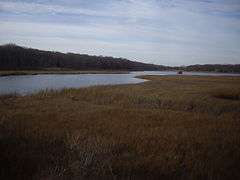Fort Corchaug Archaeological Site
|
Fort Corchaug Archeological Site | |
|
Fort Corchaug Vicinity | |
| Location | Cutchogue, Town of Southold, NY |
|---|---|
| NRHP Reference # | 74001308 |
| Significant dates | |
| Added to NRHP | January 18, 1974[1] |
| Designated NHL | January 20, 1999[2] |
Fort Corchaug Archeological Site is an archaeological site showing evidence of 17th century contact between Native Americans and Europeans. Fort Corchaug itself was a log fort built by Native Americans. It may have been to protect the Corchaug tribe from other Indians, built with the help of Europeans.[3] Ralph Solecki, a prominent American archaeologist, grew up nearby and conducted several digs on site.[4]
It remains today one of the few undisturbed Indian Fort archaeological sites in the North East.[5] and was declared a National Historic Landmark in 1999.[2]
The Corchaug tribe, also known as the Montaukett, originally had the land from the Nassau border to Montauk point. Depradation by the Narragansetts of Connecticut and decimation from smallpox caused to tribe to leave their land in the South fork and with the help of whites built forts to ward off attacks. Another fort still being excavated is Fort Hill in Montauk Point, described as "one of the earliest and best for its time", it was placed on a 1658 map of Long Island.[6]
References
- ↑ National Park Service (2007-01-23). "National Register Information System". National Register of Historic Places. National Park Service.
- 1 2 "Fort Corchaug Archaelogical Site". National Historic Landmark summary listing. National Park Service. 2007-09-11.
- ↑ Newsday.com Article on Site
- ↑ NY Times article
- ↑ Fort Corchaug History
- ↑ http://montaukett.org/?page_id=22
- ↑ ""The Promise of Corchaug: Archaeologists hope a buried fort will reveal new secrets of Indian Civilization" by Steve Wick". Newsday. Undated, downloaded 9/2007. Check date values in:
|date=(help)
Coordinates: 41°00′09.66″N 72°29′55.48″W / 41.0026833°N 72.4987444°W


